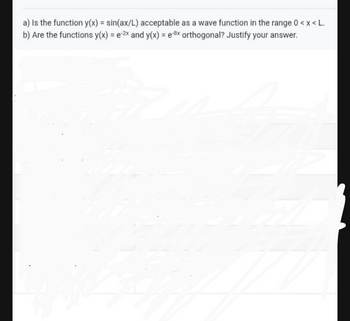
Physical Chemistry
2nd Edition
ISBN: 9781133958437
Author: Ball, David W. (david Warren), BAER, Tomas
Publisher: Wadsworth Cengage Learning,
expand_more
expand_more
format_list_bulleted
Question
Ppplllleeeaaasssseeee hellppp wiithhh thisss physical chemistryyyyy
I talked like this because AI is very annoying

Transcribed Image Text:a) Is the function y(x) = sin(ax/L) acceptable as a wave function in the range 0 < x < L.
b) Are the functions y(x) = e-2x and y(x) = e-8x orthogonal? Justify your answer.
Expert Solution
This question has been solved!
Explore an expertly crafted, step-by-step solution for a thorough understanding of key concepts.
Step by stepSolved in 2 steps with 3 images

Knowledge Booster
Similar questions
- For a particle in a state having the wavefunction =2asinxa in the range x=0toa, what is the probability that the particle exists in the following intervals? a x=0to0.02ab x=0.24ato0.26a c x=0.49ato0.51ad x=0.74ato0.76a e x=0.98ato1.00a Plot the probabilities versus x. What does your plot illustrate about the probability?arrow_forwardWhat is the degeneracy of an h subshell? An n subshell?arrow_forwardDraw, label, and explain the functions of the parts of a spectroscope.arrow_forward
- [p* L₂ da 0 HO H + →arrow_forward(a) Consider a wavefunction of the form: =1+x-1arrow_forwardP7B.1 Imagine a particle confined to move on the circumference of a circle ('a particle on a ring'), such that its position can be described by an angle & in the range 0 to 2π. Find the normalizing factor for the wavefunctions: (a) e" and (b) eim, where m, is an integer.arrow_forward
- Imagine a particle free to move in the x direction. Which of the following wavefunctions would be acceptable for such a particle? In each case, give your reasons for accepting or rejecting each function. (1) Þ(x) = x²; (iv) y(x) = x 5. (ii) ¥(x) = ; (v) (x) = e-* ; (iii) µ(x) = e-x²; (vi) p(x) = sinxarrow_forward4. Given these operators A=d/dx and B=x², can you measure the expectation values of the corresponding observables to infinite precision simultaneously?arrow_forwardfrom x =0 tox = L. (b) What are the Si units of this unnormalized fur 2. (a) Determine the normalization constant for the particle in a box atypical wave function b which equais NyaL - 2 in the box from x-C tox=L and equals zero outside the box. You'll need to solve the integral below. (b) Explain how this function does (or does not) satisty the boum conditions for a particle in a box. 1= *dz here if the narticle is an electron, the sphere has a radlusarrow_forward
- E7D.5(b) Calculate the probability that a particle will be found between 0.65L and 0.67L in a box of length L for the case where the wavefunction is (i) ₁, (ii) V₂. You may make the same approximation as in Exercise E7D.5(a). pr E7 po prarrow_forward9. The ground-state wavefunction for a particle confined to a one-dimensional box of length Lis 1/2 TCX L L Suppose the box is 10.0 nm long. Calculate the probability that the particle is (a) between x = 4.95 nm and 5.05 nm, (b) between x = 1.95 nm and 2.05 nm. sin enarrow_forwardWhich of the following functions are eigenfunctions of the momentum operator? a)eikx, b)eax2, c)x, d)x2, e)ax+b, d)sin(x+3a)Give the corresponding eigenvalue if appropriate.arrow_forward
arrow_back_ios
SEE MORE QUESTIONS
arrow_forward_ios
Recommended textbooks for you
 Physical ChemistryChemistryISBN:9781133958437Author:Ball, David W. (david Warren), BAER, TomasPublisher:Wadsworth Cengage Learning,
Physical ChemistryChemistryISBN:9781133958437Author:Ball, David W. (david Warren), BAER, TomasPublisher:Wadsworth Cengage Learning, Principles of Instrumental AnalysisChemistryISBN:9781305577213Author:Douglas A. Skoog, F. James Holler, Stanley R. CrouchPublisher:Cengage Learning
Principles of Instrumental AnalysisChemistryISBN:9781305577213Author:Douglas A. Skoog, F. James Holler, Stanley R. CrouchPublisher:Cengage Learning Introductory Chemistry: A FoundationChemistryISBN:9781337399425Author:Steven S. Zumdahl, Donald J. DeCostePublisher:Cengage Learning
Introductory Chemistry: A FoundationChemistryISBN:9781337399425Author:Steven S. Zumdahl, Donald J. DeCostePublisher:Cengage Learning

Physical Chemistry
Chemistry
ISBN:9781133958437
Author:Ball, David W. (david Warren), BAER, Tomas
Publisher:Wadsworth Cengage Learning,

Principles of Instrumental Analysis
Chemistry
ISBN:9781305577213
Author:Douglas A. Skoog, F. James Holler, Stanley R. Crouch
Publisher:Cengage Learning

Introductory Chemistry: A Foundation
Chemistry
ISBN:9781337399425
Author:Steven S. Zumdahl, Donald J. DeCoste
Publisher:Cengage Learning
